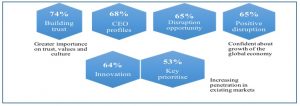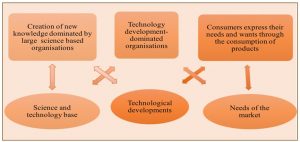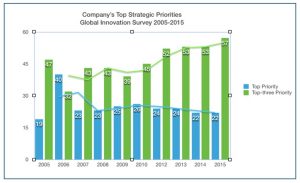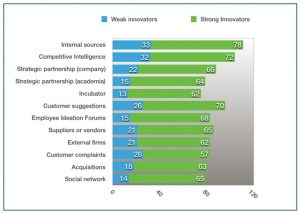Introduction
A great deal of studies shows that global corporations face a challenging growth prospect and new innovative mind-sets have premier spots on the Top Management Agendas. R&D spending is not the key driver for innovation success but a number of elements that structure a successful innovation system to create value across the lifecycle of organizations. At the core, there are strategy, IT processes, governance, culture and innovation management, which are a combination of the innovative processes and changes management or the business process of organizational innovation through development.
Many SMEs fail because they do not recognise the need for change; on the other hand even to giant firms, the core strength can sometimes become an obstacle to see the need for change (as proved to be the case of IBM in the ‘90s). Therefore, the company’s supporting culture need to launch strategies and plans to close the identified gaps.
In a research study by Mateescu et.al (2015), in recent years not only international corporations but also national ones have started using new management implements and methods, and started focusing on distinguishing their innovation management strategies from the competitors by adapting to the customers’ needs and providing high-quality services. Consequently, as Drucker (2011) describes, innovating firms develop their own unique realisation and subsequent capabilities that generate organisational performance.
According to Berger et. al. (2009), three essential traits are advisable for innovation management: positive encouragement, a tolerance for failure (Patrick Cescau, George Buckley) and patience (Olli-Pekka Kallasvuo). Additionally, an innovative organisation should be closely linked to the company’s vision and overall business strategies based on comprehensive and relevant information, both from inside the corporation and from the market and the environment. Thus, today’s companies must constantly adapt, develop and innovate, so as to handle the challenges of future innovation management, including the importance of quick results, the value of data-driven decision-making and the particular environment of emerging markets.
The 2017 KPMG’s Global CEO Outlook divulges insights from nearly 1,300 CEOs in 10 of the world largest economies focusing on how managing their organizational change has become their vital opportunity to transform and re-shape their business model, since new technologies emerge, new markets appear, in addition, financial policies, social rules, information flow, targets and new challenges are constantly changing.

Fig.1: Global CEO Outlook 2017 Source: KPMG
RegTech is another significant driver of organizational change, as the global demand for regulatory, compliance and governance software is expected to reach €100.98 billion by 2020. Besides, investments in regulatory software can lead to an ROI of 600% plus, according to Fintech insights provider Let’s Talk Payments. CEOs recognise the need of making changes, yet they are refraining from harnessing the power of disruption for their organisations.
According to a very recent research by Burrowes (2017), PwC’s global chairman Bob Moritz working on the 20th year of annual CEO survey revealed that 84% of Banking and Capital Market CEOs consider that technology will completely reshape, or at least have a significant impact on competition within their industry over the next five years.
Theoretical Considerations on Innovation Management
In the book by Peters and Waterman (2012), the principles and disciplines of the productive innovation management are crucial determinants and focus on how the enterprise accomplishes the initiative and studying process towards more effective practices and business excellence. The concept of innovation management incorporates networks of people that have appropriate knowledge including customer insight, supply chain knowledge and technical expertise, which allows companies of all sizes to make innovation an integral part of their business.
The core process of innovation management involves four steps: distinguishing opportunities, discovering resources, developing the enterprise and capturing value. The procedure of strategic management starts with creating a flexible organization in order to determine if the innovation management is consistent with the strategic management objectives and to pitch a great idea to the right market at the right time.
There is a substantial double role of innovation management: the challenges in finding new innovations, such as an unexpected use for technology, as well as developing new directions for innovation management models.

Fig.2: Conceptual Framework of Innovation
Furthermore, organisational merit within innovation management will be achieved by companies which can react quickly to new market conditions and customer needs, and which constantly look for creative and innovative solutions. Accordingly, the success of Johnson & Johnson, 3 M, Wal-Mart, and HP lies in the fact that they organise themselves into small, independent units and hold together by common goals and cultural norms, on the other hand, IBM is satisfying the individual’s need to be a part of something great. Moreover, as Knight and Cavusgil (2004) state in their research paper, due to technological advances, cross-border unions for product distribution as well as the increasing homogenization of consumer preferences have been facilitating extraordinary growth in global competitiveness.
Empirical Considerations on Strategic Innovation Management
Innovation management has a gap between scientific and organizational progress, since the problem with innovation determinations is embedded in the lack of innovation strategy. A precise innovation strategy helps the company to design an organization to match its specific competitive needs. Senior leaders of the corporations need to organize around long-term strategies for growth in a sustainable way, not only short-term technologies; accordingly they have to start planning for the next 10 years, not only for the next one-two years. The failure to prioritize innovation over short-term profits can have negative flows through capital markets.
There has been little empirical research aimed at uncovering the actual packages of know-hows that characterise truly innovative firms, therefore I will try to reduce the literary framework and focus mainly on the recent period, and consistent with these state-of-the-art findings, prefigure the best organizational change strategies. According to these changes, the global corporations have to apply continuous innovative strategies in order to maintain global competitiveness.
In 2017, the Boston Consulting Group analysed the top 210 firms in seven industries (automotive, chemicals, consumer goods, financial services, media and publishing, technology, and telecommunications) and found that the proliferation of new technologies are making the new models competitive necessities, not optional activities. Consequently, 1,500 survey respondents were asked to rank innovators within their industries. Evolving data from multiple sources has helped scores of companies better recognise the choice of prospects open to them and pinpoint possibilities for business model innovation. The BCG’s 10th annual global survey shows that 79% of respondents ranked innovation the top-most priority or among their three top priorities at their corporation.
According to the Information Technology and Innovation Foundation, revised by McKinsey (2015), the profits of corporations will drop 20% – 60% by 2025 if they downfall to advance digitally. Therefore, companies have to make the leap from the Industrial Age to the Information Age and CEOs will need to embrace strategic innovation management, which requires alternative capital allocation that leads to exponential growth in the pursuit of longer-term goals.

Fig.3: Global Innovation Survey 2005 – 2015 Source: BCG
The 2016 European Innovation Survey shows that only 16% of the respondents apply effective business methods and practices regarding innovation strategy, idea management, innovation budgeting, innovation funnel and innovation board simultaneously. Professor of Finance at Stanford Amit Seru claimed that companies in the top 10% on innovation experienced annual rates between 1% and 3% faster than those corporations with only an average pace of innovation. According to Andrews (2017), using the simplest and most economic models indicate that an innovative flow increases the total economic growth by at least 4.5%.

Fig.4: Strong and Weak Innovators; Based on BCG Global Innovation Survey 2016
Despite the above seen positive results, even the strong innovators are faced with a truly difficult assignment:
- Find the next big idea (Competitive intelligence 72%)
- Avoid disruption (Customer suggestion 70%, Customer complaints 57%)
- Fast-track innovation (Social network or big data mining 65%, Suppliers or vendors 65%)
- Build networks of collaborators (Strategic partnership – company 66%, strategic partnership – academia 64%)
- Stay on top of the revolutionary technology (Acquisitions or licensing deals 63%, Incubator 62%)
- Identify growth opportunity (External firms they hire to generate ideas 62%)
- Attain a position of innovation management (Internal sources 78%, Employee ideation forums 68%)
On the one hand, the huge amount of data, which is available to help senior leaders shape and pursue innovation strategies could be a prominent advantage, on the other hand, the hard work of sorting, organizing and gathering usable insights from thousands of files and sources can be overwhelming and exasperating to make analytics-driven strategic decisions.
Overall, in a previous study, Takacs (2017) states that a successful innovation management should invest in strategy thinking methods, and support for diverse cultures in order to join people with different perspectives to share ideas and new approaches, combining entrepreneurial mind-sets with recognized and functioning expertise.
Research Objectives and Methodology
The objective of this study is to identify the key criteria that affect the organisational change strategies, as well as to do research on the degree of innovation management in global companies. The author has focused on the top most innovative corporations as key players in transforming strategy into practical accomplishment and their relation to the owner of business superiority to be applied.
This research shows that innovative companies are especially skilful at continually responding to change of any sort and encourage practical risk taking and support worthy attempts, as well as organise the root source of quality and productivity gain. In terms of research approach, I have used the rational model as my contextual framework to illuminate what values and practices ought to be incorporated into the innovative companies and to emphasise the role of the CEOs to manage the innovative principles of the organisation.
The methodology used involves interviews with managers and experts from global corporations in order to gather information for the time frame 2007 to 2017, according to Le Merle & Davis (2017) that was evaluated and applied in a case study so to propose a method of analysing innovative factors. This study debates the increasing diversification of implementations these global corporations have used to practise innovation management.
Assuming rational choices, the top companies were studied into various categories in order to analyse them according to long-term superiority: high technology companies (HP, Intel), consumer goods companies (P&G, J&J), general industrial goods companies of interest (Caterpillar, 3M), service companies (Marriott, McDonald’s), project management companies (Bechtel and Fluor) and resource-based companies (Arco, Exxon).
Having reviewed a list of the world’s most valuable companies, which are ranked by market capitalization, it was found that they are all strongly associated with four vital attributes, namely an emphasis on speed, well-run R&D processes, the use of technological platforms and the systematic exploration of adjacent markets. In addition, by way of Dogsofthedow (2017) states, these companies also apply the most innovative strategies in the world, as we can see it comprised in the table below:
Table1: Market Cap Rank in 2017

Source: Dogsofthedow.com
Summarizing a number of different perspectives, as Schwab (2016) revised it, focusing on each part of the 12 pillars of global competitiveness, the case study brings a more comprehensive and brighter evaluation on the innovative strategic system to have an integrative understanding of all its parts, while this is the only way that leads to sustainable development, indicated Maier et.al. (2014).
Research Results and Proposed Models
My key findings from the analysis are that global companies have a huge positive impact on the growth of organisations they fund, thus, with the analysed case study the role of innovative culture is better understood and new insights reveal the key innovation management strategies that maintain global competitiveness and professional merit among the global corporations, as also Greenberg et.al. (2017) state.
The presented results of my research highlight the traits of the organizational change and offer some practical solutions and models for integrating as well as promoting innovative advances into strategic management that enhances financial results. While the need to innovate may threaten business models, it also creates short-term and long-term openings for the companies that grasp organizational change.
Wrigley & Straker (2016) suggested several models that can be employed and selected by each company according to their profiles and ventures. While innovation management and strategic management processes can be defined through organizational change, corporations show great interest in implementing these models, which can promote creativity and motivational orientation to succeed through innovation. The following models have been examined with a view to provide steps towards actual applications:
- The use of Corporate Venture Capital increased from 27% in 2010 to 40% in 2015 among the 30 largest companies. Likewise, among the top 10 companies it has boosted from 41% to 57%, where the investments were strategically focused on software industry reflecting the increasing value of data and the transformation of hardware to software. CVC is an effective tool for both constructing value and developing innovative results that help a corporation in creating new revenue streams, and building up competitive market position. According to KPMG analysis, 30% of projects are financed globally by this model.
- The use of Accelerators and Incubators are the most common alternative to CVC, which increased from 2% to 44% among the 30 largest companies as well as from 4% to 66% among the 10 largest corporations. Growing accelerators and incubators form partnerships with venturing operations from other organisations or teaming up with independent accelerators with common interests can support the progress of innovative developments, especially at an early stage.
- The use of Innovation Labs among the 30 largest companies increased from 5% to 19% and from 16% to 41% among the top 10 largest corporations, which worked these labs further along the development chain to fast-track time to market and they often interacted with external entrepreneurs. The main focus of this model is on advancing products or services that are head-to-head to the core business.
All the three models can be employed at a particular stage with a specific goal: Corporate Venture Capital when the restraints are related to funding, Accelerators and Incubators for young ideas, and Innovation Labs for mature corporations, which have a strong strategic fit and approach to innovation within the corporation.
Companies are also employing many other implementation tools, such as Hackathons (software developers), jurors or mentors (to spot business models), scouting missions (to seek out innovations), corporate-university partnerships (between corporate R&D and university researchers), strategic partnerships (to bring the latest innovations to new market), start-up acquisitions (to access new technologies or market), and licensing (customer segments).
Conclusions
The research showed that organizations need a play-to-win strategy system, which provides a clear measurement (Dobbs & Koller 2015), motivations, reasons and rewards to foster improvement that is aligned with their innovation management. Successful corporations develop innovation management models that are well-matched with their positions and reflect their corporate strategies, in addition, they also adapt their models to change times as the pace and stake of technology advancement progresses.
Companies that assign adequate assets for a flexible and dynamic innovation and venture culture have the greatest chance to assure long-term business achievement. The success of Johnson & Johnson, for example, one of the strongest long-time innovators in any industry, is that their innovation programs are strategically aligned with the corporation’s innovation management objectives.
In conclusion, innovation management stems from a management team that combines deep scientific and technical expertise focusing with an equally deep knowledge on market needs. Therefore, innovation management must be one of the greatest progression strategies that companies employ, coupling scientific precision with stable senior-management cohesion and the resolution to pursue high-risk, high-return initiatives. The case study meant to be a thorough analysis of recent data for reasons connected to the methodology and leaving room for future academic and practical expansion.
References
- Andrews, E., (2017), “Is Tech disruption good for the economy?”, Stanford Business. [Online], [Retrieved September 12, 2017], https://www.gsb.stanford.edu/insights/tech-disruption-good-economy
- Berger, R., Dutta, S., Raffel, T., Samuels, G. (2009) Innovating at the Top: How Global CEOs Drive Innovation for Growth and Profit, Palgrave Macmillan, New York.
- Dobbs, R. & Koller, T. (2015), ‘Playing to Win: The new global competition for corporate profits’, McKinsey, 55-65.
- Dogsofthedow, (2017), “Largest companies by market cap today”. [Online], [Retrieved August 30,2017], http://dogsofthedow.com/largest-companies-by-market-cap.htm
- Drucker, P. F. (2011) Innovation and Entrepreneurship: Practice and Principles, Routledge, New York.
- Greenberg, E., Hirt, M. and Smit, S. (2017), ‘The Global forces inspiring a new narrative of progress’, McKinsey Quarterly.
- Burrowes, K. (2017) ‘Banking on disruption: how the BCM sector can turn change into a competitive advantage’, PwC Global.
- Knight, GA and Cavusgil, S.T. (2004), ‘Innovation, Organizational Capabilities and the Born-Global Firm’, Journal of International Business Studies 35(2):121-141.
- Le Merle, M C. and Davis, A. C. (2017) Corporate Innovation in the Fifth Era: Lessons from Alphabet/Google, Amazon, Apple, Facebook, and Microsoft, Cartwright Publishing, Corte Madera.
- Maier, D., Olaru, M., Weber, G. and Maier, A. (2014), ‘Business Success by Understanding the Process of Innovation’, The 9th European Conference on Innovation and Entrepreneurship (ECIE), ISBN: 978‐1‐910309‐45‐2, 18-19 September 2014, Belfast, UK.
- Mateescu, R., Olaru, M., Lange, S., Rauch, M. (2015), ‘Study On Supplier Invoice Risk Management in A Global Supply Chain’, The 26th IBIMA conference on Innovation Management and Sustainable Economic Competitive Advantage: From Regional Development to Global Growth, ISBN: 978-0-9860419-5-2, 11-12 November 2015, Madrid, Spain.
- McKinsey, (2015), “The Fight for the Customer: McKinsey Global Banking Annual Review 2015” 3, [Online], [Retrieved August 29, 2017], http://www.mckinsey.com/industries/financial-services/our-insights/the-fight-for-the-customer- mckinsey-global-banking-annual-review-2015.
- Ringel, M., Taylor, A., and Zablit, H. (2017), ‘The most Innovative Companies 2016, Getting past “Not invented here”. The Boston Consulting Group, 3-15.
- Peters, T.J. and Waterman, H.R. (2012) In Search of Excellence: Lessons from America’s Best-Run Companies, Harper Collins, New York.
- Schwab, K., (2016), “The Global Competitiveness Report 2016-2017”, World Economic Forum. [Online], [Retrieved September 10, 2017], https://www.weforum.org/reports/the-global-competitiveness-report-2016-2017-1
- Takacs, I.Cs. (2017). ‘Study of cross-cultural challenges in the international business administration’ Proceedings of BASIQ International Conference New Trends in Sustainable Business and Consumption, ISSN: 2457-483X, 31 May-3 June 2017, Graz, Austria, 657-666.
- Wrigley, C and Straker, K. (2016), ‘Designing innovative business models with a framework that promotes experimentation’, Strategy & Leadership, 44(1), 11-19.







